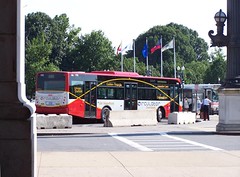Speaking of bus marketing part 2
Paul Wolf takes issue with the entry from last week "The first priority for Bus shelters ought to be marketing transit".
Your blog about how bus stops should advertises buses is very strange.
I have taken the Georgetown route more than once on impulse. For years, I have occasionally ridden the Metrobus D6 route, and a few others, but they require advance planning with the schedule because they run so irregularly and infrequently. No amount of advertising could get me to ride Metrobus more often. You can't ride a bus that isn't there! On the other hand, no advertising at all is necessary to get me to ride the circulator.
____________
Well we're gonna have to agree to disagree on this one. But I have to say that your "ur" point is correct. A crappy bus-busline-bus system won't succeed regardless of how much you advertise it.
Let's accept as a given that the system isn't crappy (although there are many routes that need more love). Then, my point makes sense--bus shelters and stops are "point of purchase" transit promotion locations. This means (1) that each bus stop needs a map of the route (which also shows links to other routes) and a printed schedule and (2) these materials market transit not just to current users but to potential users as well, by having access by otherwise hard-to-find or codified information. And this relates to my overall point that having a great bus waiting environment communicates that transit is valued and offers value.
I write a lot about buses and I do ride them, but now that I bike (since mid-1990) I don't ride the buses every day like I once did.
I have been critical of the Circulator because of its low ridership but in some respects it "merely" needs a good dose of guerilla marketing, in particular "transit promotion" events in the lobbies of the various office buildings along the routes. I did see a Downtown Circulator bus at the "Arts on Foot" event on Saturday, and these buses have been displayed at Washington Nationals baseball games and other places.
 Bus Rapid Transit signage in Los Angeles. A model for DC?
Bus Rapid Transit signage in Los Angeles. A model for DC? Information challenged at the Downtown Circulator bus stop at Union Station. Photo by BeyondDC. Used by permission.
Information challenged at the Downtown Circulator bus stop at Union Station. Photo by BeyondDC. Used by permission.To explain how the system works, there needs to be a placemarker comparable to LA's MetroRapid Sign at Union Station. Such a sign needs to be placed inside the Union Station subway station, in the vicinity of the MARC office in Union Station so that people disembarking from the MARC commuter trains** can learn about the Circulator, as well and in other key Metro stations along the route such as Gallery Place and Farragut North, so that more people can be educated about how the Downtown Circulator works.
**Maybe there could be Downtown Circulator promotions done in association with MARC.



0 Comments:
Post a Comment
<< Home